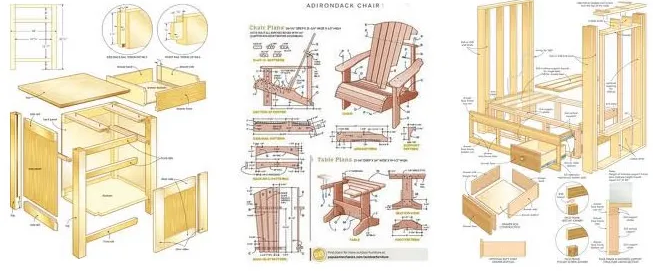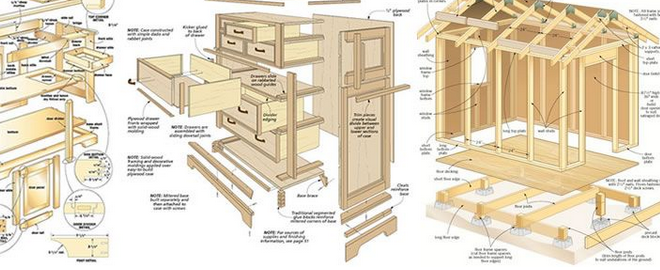Woodworking, a timeless craft that transforms raw timber into functional artistry, is a pursuit that relies on precision, skill, and creativity. In this guide, we explore the invaluable role of these documents in the woodworking plans and blueprints.

The Blueprint’s Unveiling
Blueprints: The Navigator of Woodworking Projects
Blueprints, sometimes referred to as woodworking plans, serve as a craftsman’s guiding star. These meticulously detailed documents provide a roadmap for creating wooden masterpieces. They encompass measurements, angles, materials, and construction steps. For woodworkers, blueprints are akin to a treasure map, revealing the path to a finished work of art.
Blueprints Bring Order to Chaos
Imagine embarking on a woodworking project without a blueprint. It’s like setting sail without a map in uncharted waters. Blueprints bring order to the chaos of raw materials, offering precise measurements and directions to ensure a successful build.
Blueprints as Creative Enablers
While blueprints provide structure, they also leave room for creativity. Skilled woodworkers often use them as a foundation and then inject their unique flair, modifying designs to meet specific aesthetic or functional preferences.
Crafting the Perfect Blueprint
The Blueprint Creation Process
Creating woodworking blueprints is an art in itself. It begins with a concept, evolves through meticulous planning, and culminates in a comprehensive document. Woodworkers and designers collaborate to transform ideas into tangible plans.
Precision is Paramount
Precision is non-negotiable in blueprint creation.
Adapting to Wood Characteristics
Experienced woodworkers understand that wood has characteristics that can vary from one piece to another.
The Blueprint’s Versatility
Blueprints for All Skill Levels
Blueprints cater to woodworkers of all skill levels. Beginners can find simple, step-by-step plans to kickstart their woodworking journey. Intermediate and advanced woodworkers can access more complex designs that challenge their craftsmanship.
Blueprints for Diverse Projects
Woodworking blueprints span a wide range of projects. From small-scale items like cutting boards and birdhouses to larger undertakings like furniture and cabinetry, there’s a blueprint for nearly every wooden creation.
Blueprint Accessibility
Traditional vs. Digital Blueprints
While traditional paper prints still have their place, digital prints are gaining popularity. They offer the advantage of easy sharing, quick duplication, and zoom capabilities, making them a valuable resource for modern woodworkers.
Blueprint Libraries and Repositories
Online platforms host vast libraries of woodworking, making it easier than ever for woodworkers to access a wealth of design options. Many of these resources are free or available at a nominal cost.
The Blueprint Benefits
Efficiency and Time Savings
Blueprints streamline the woodworking process. Woodworkers can avoid the trial-and-error approach, significantly reducing project time and materials wastage.
Error Prevention
Precise measurements and detailed instructions in these prints minimize the risk of errors. This results in a higher likelihood of a successful project outcome.
Enhanced Skill Development
Blueprints are not just instructions; they are educational tools. Following them helps woodworkers learn new techniques, expand their skill sets, and gain confidence in their abilities.
Customization and Personalization
Blueprints offer a solid foundation for customization. Woodworkers can adapt designs to incorporate unique features, ensuring each piece is one of a kind.
The Blueprint as a Lifelong Companion
A Source of Inspiration
They serve as a wellspring of inspiration. Even when not following a specific plan, woodworkers often flip through these prints to spark ideas for their next project.
Sharing the Craft
Experienced woodworkers often create and share their own these prints. This practice fosters a sense of community and mentorship, ensuring the craft continues to thrive.
Conclusion
Woodworking plans and prints are the unsung heroes of woodworking. They transform concepts into tangible creations, offer guidance to both novices and experts, and encapsulate the spirit of craftsmanship. As woodworking evolves in the digital age, the blueprint remains a steadfast companion, guiding hands and hearts in the timeless art of working with wood.


